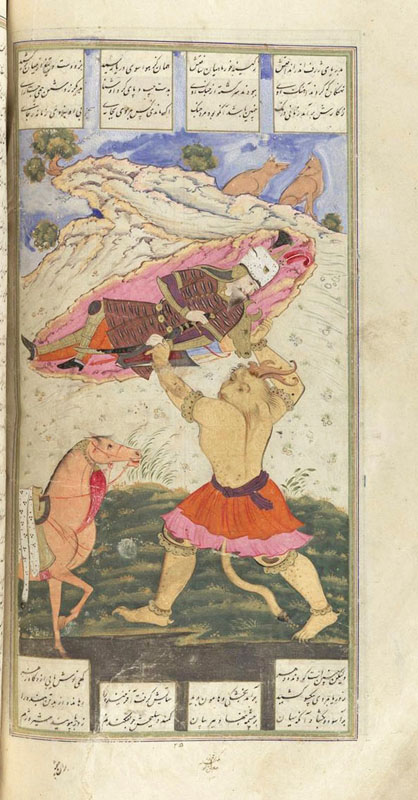The Demon Akvān Flings Rostam into the Sea
As Charles Melville has pointed out that the illustration comes a little late in the text of the manuscript, at a point where Rostam is already in the water struggling against sea monsters. The painting however, depicts the precise moment in the story when Akvān had raised Rostam, still sleeping on the patch of earth, over his head and is about to cast him into the sea. In this respect the composition follows the traditional rendering of the scene. However, Rostam’s leopard skin saddle cover still appears draped on the saddle, yet the appropriate passage in the text clearly states that before Rostam laid down to sleep he placed it under his head as a pillow.
The background, typical for Moʿin, is a sloping hillside that reaches a craggy crest near the top of the painting, where grow a few green bushes. At the base of the hill in the foreground is a green expanse on which the action is taking place, and in the extreme foreground is a suggestion of the sea into which Rostam is about to be dispatched. The div Akvān, wearing only a skirt and braclets on its arms and legs, has humanoid characteristics of large and muscular proportions, combined with long floppy ears, horns, a tail, claws, and hooked appendages on its heels. Standing with its legs wide apart, the div raises the bewildered Rostam, still reclining on a chunk of earth, above its head and is about to cast him asunder. His faithful horse Rakhsh, whose forequarters can be seen in the left foreground, whinnies an alarm, while in the upper right two jackals scamper along the ridge line.
Painting: 26.75 x 16.5 cm. There are three lines of four column text above the illustration. Below there are three lines in the outer columns, and two lines in the central columns. A rectangular frame encloses painting and text. The miniscule signature, raqam-e kamina fażl ʿali, appears in the upper left just to the right of the shrub. In the lower margin, written in Moʿin’s hand, is the signature raqam-e kamina moʿin-e moṣavver and the date 1104/1693. Attributed by Jackson and Yohannan to Fażl ʿAli, and by Robinson to Moʿin with the assistance of Fażl ʿAli. The overall style is very much that of Moʿin Moṣavver. Yet the signature of Fażl ʿAli suggests that Mo¯in had assistance.
Painting references:
J&Y_1914, p.37, no.26 (not ill.).
Robinson, Cochran4_1972, p.78, no.26 and p.83, fig.16.
Cambridge Shahnameh Project
Text references: Warner, III, pp.276-78; Mohl, III, pp.222-23; Levy, pp.148-49.
Robert Eng
Last Updated: February 17, 2011 | Originally published: June 18, 2003
